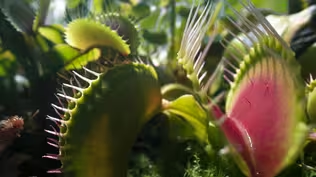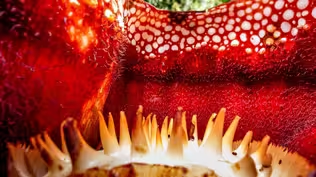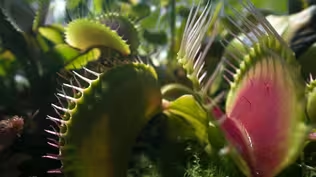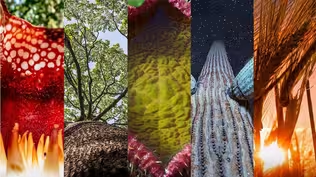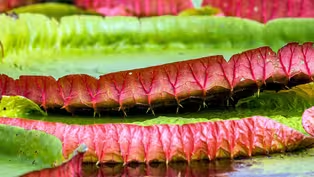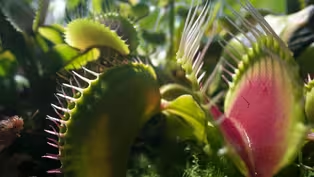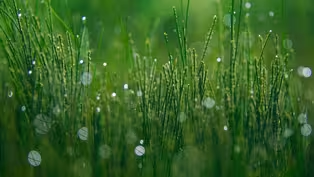
Water Worlds
Episode 2 | 55m 55sVideo has Audio Description, Closed Captions
Sir David Attenborough discovers amazing water plants, some of which can count and hunt.
Sir David Attenborough explores bizarre and beautiful water plants, which use nature's super-glue, counting, and killer spikes to get a leaf up. Some escape from animals by rolling away while others create bubbles in a magical river in Brazil.
See all videos with Audio DescriptionADProblems playing video? | Closed Captioning Feedback
Problems playing video? | Closed Captioning Feedback

Water Worlds
Episode 2 | 55m 55sVideo has Audio Description, Closed Captions
Sir David Attenborough explores bizarre and beautiful water plants, which use nature's super-glue, counting, and killer spikes to get a leaf up. Some escape from animals by rolling away while others create bubbles in a magical river in Brazil.
See all videos with Audio DescriptionADProblems playing video? | Closed Captioning Feedback
How to Watch The Green Planet
The Green Planet is available to stream on pbs.org and the free PBS App, available on iPhone, Apple TV, Android TV, Android smartphones, Amazon Fire TV, Amazon Fire Tablet, Roku, Samsung Smart TV, and Vizio.

The Green Planet
Dive into the extraordinary world of plants with articles from The Green Planet.Providing Support for PBS.org
Learn Moreabout PBS online sponsorship♪ ♪ David Attenborough: Plants cover much of the land surface of our planet, but there is another extraordinary green world that is often hidden from us.
♪ It's one where plants have overcome huge challenges in order to survive... ♪ the world of freshwater.
♪ At first sight, a lake like this would seem to have everything that life needs in order to thrive-- clear, oxygen-rich water, plenty of dissolved nutrients and minerals, and lots of sunlight, but in fact, life in freshwater presents plants with huge problems.
To succeed, plants have had to abandon many of the adaptations that served them so well on land and evolve something quite new, and doing that, they have created some of the most beautiful and bizarre and important habitats on Earth.
♪ There are few places where it's more difficult to make a permanent home then a freshwater torrent like this one.
♪ Violent currents... rip across the riverbed, scouring it clean... [Rocks clattering] [Whoosh] ripping land plants from their margins and drowning them.
♪ How could any plant survive in a place like this?
Yet even here, some do manage to quite literally hold on.
They can grasp the bare rock with remarkable strength.
This ability allows plants to thrive in these otherwise hostile environments.
[Birds chirping] ♪ This is the Cano Cristales River in Colombia.
♪ These plants are red Macarenia, sometimes called the orchid of the falls.
♪ They cling to the riverbed not with their roots but with their stems glued to the rock surface by one of the most powerful adhesives in nature.
♪ The rock itself will break before these anchors lose their grip.
♪ These feathery filaments are their modified leaves, and they do what roots normally do, gather the minerals and nutrients they need that are dissolved in the water.
♪ With such spectacular colors, it's hardly surprising that the Caño Cristales is sometimes called the most beautiful river on Earth.
♪ But being rooted to the spot is not always the best strategy for living in a water world.
♪ This is a water lettuce, and it has some remarkable adaptations.
Its roots hang free, so it's not anchored to the ground, and its leaves are thick and spongy and covered in fine hairs so that the plant itself is more or less unsinkable.
♪ This combination of characteristics enable the water lettuce to do something that almost no land plant can do.
It can travel.
♪ In Brazil during the wet season, flooded rivers become highways for travelers.
♪ This water lettuce is not the only traveler here.
♪ Water hyacinths buoyed up by air bladders are also on the move.
♪ Further downstream, there will be new opportunities for plants like these... but the journey is hazardous.
♪ [Splash] ♪ Spider monkeys.
Their agility on thin branches allow them to live where the forest hangs over the water.
Passing plants are a valuable addition to their diet.
♪ Only those that pass by far from the bank are safe.
♪ This is the largest inland water world on Earth, the Pantanal.
For a few months every year, it provides water plants with ideal conditions... ♪ But all too soon, it becomes a battleground.
♪ Plants are racing to claim their space on the surface.
♪ The water lettuce rapidly expands its network of hanging roots so that it starts absorbing nutrients before other competitors arrive.
♪ Water hyacinth appears.
♪ Its leaves are carried on stalks filled with air that also make it virtually unsinkable.
♪ The race for space intensifies.
♪ A new competitor arrives, Ludwigia.
It spreads by developing a chain of tiny rafts and jostles for space with the densely packed leaves of mosaic plants.
♪ All are racing to claim as much sunlight as possible.
♪ They flower quickly before the floodwaters recede.
♪ And these surface dwellers also have competitors... including one that has been waiting in the depths and is now stirring.
[Water bubbling] ♪ It's a monster.
♪ It's well-armed.
♪ It clears space for itself... ♪ by wielding one of its buds like a club... ♪ and now it dominates the surface.
♪ This is a leaf of the giant water lily.
♪ It expands by over 8 inches a day and reaches more than 6 feet across.
♪ Its immense leaves are supported a network of air-filled struts and protected by one-inch-long spines.
The leaves float high in the water, and their surfaces are dotted with tiny holes, drains, that help them ensure that rainwater doesn't accumulate and sink them.
♪ [Water squirting] ♪ Nutrients from the fertile mud below are carried up by tubes in its stem to fuel the leaf's expansion.
♪ Over the next few months, the lily will produce some 40 or so of these gigantic leaves... ♪ and as each one reaches the surface and expands, more and more light is taken from those plants that are trying to grow beneath.
♪ Competitors are pushed aside.
♪ Some are crushed or skewered.
[Loud rip] ♪ Eventually, its immense leaves press their margins against one another, totally cutting off the light from the plants beneath them.
♪ The battle is over, and victory is total... ♪ but the losers in this war do not go to waste.
♪ These stranded water lettuce break down and rot, and as they do so, they become a magnet for swallowtail and sulfur butterflies.
♪ Every one of them is male.
♪ Their reproductive organs cannot mature without essential salts.
The decaying plants supply all they need.
♪ The journey of the water lettuce may have come to an end, but their influence will continue in the form of new generations of brilliantly colored butterflies.
♪ The frozen water world of Lake Akan in northern Japan... ♪ home to one of the strangest and most primitive of plants.
It's an alga like those that appear so mysteriously in our ponds... ♪ but this one is truly extraordinary.
♪ Each spring, the melting ice releases soft, velvety balls of interwoven threads called marimos.
♪ This one is small, no bigger than a walnut, but there are lots of them here.
♪ They attract the attention of visiting whooper swans... ♪ but there is one way for the marimo to escape from the danger, and it depends on a change in the weather.
♪ Fortunately, in the spring, winds sweep across the lake, creating currents that carry some of the marimos beyond the reach of hungry swans.
♪ It's a start of a remarkable journey.
♪ They are gently carried back and forth by the currents so that the marimos become more and more spherical... ♪ and slowly they travel into deeper water.
♪ Here, there are great numbers of them, certainly many millions.
Some are the size of basketballs.
♪ They're safe from swans, and the water is still shallow enough for some sunlight to reach them.
It seems a perfect home, and so it is...almost.
The snag is that these waters also carry a fine sediment that can clog the marimos' surface, cutting off the all-important light... but the marimos are not entirely immobile.
♪ They dance.
♪ The winds blowing over the lake's surface create currents beneath that are sufficiently strong to move the marimos.
♪ They rub against each other, and in just a couple of hours of gentle movement, they are all clean once more.
♪ As they spin, every part of their surface gets enough time in the sunlight to keep growing.
♪ [Birds calling] ♪ This is the heart of the Amazon.
♪ [Water rushing] ♪ [Birds chattering] ♪ There are water worlds here that are so remote that even today few people have ever seen them.
♪ This barely explored tributary is the Rio Claro, and here when conditions are just right, it's possible to witness a rare and remarkable spectacle.
♪ The river is so crystal clear that its bed is bathed in sunlight.
♪ A magical landscape of miniature mountains and valleys.
♪ It's carpeted by pipewort, fanwort, and star-grasses.
♪ As the sun climbs in the sky, bubbles of gas appear, evidence of photosynthesis.
♪ Deep inside the plants' cells, tiny structures called chloroplasts move towards the light.
♪ They absorb carbon dioxide and use the sun's power to synthesize the sugars that the plant needs to grow... ♪ and as a byproduct, they release oxygen, the gas that we and all other animals must have in order to breathe.
♪ [Glub] ♪ Now in late afternoon, bubbles of oxygen make the river water fizz like champagne.
♪ The plants can become so buoyant with gas that they rise to the surface, even carrying the bedrock with them.
♪ Only in this remote water world can this spectacular natural wonder be seen.
♪ Eastern Venezuela.
♪ Here, rectangular table mountains known as tepui stand above the tropical forest.
♪ There are more than 50 such isolated mountain plateaus here, each home to a unique community of plants.
♪ Downpours are so torrential that no soil can accumulate on their broad rocky summits, and some plants living up here have to find their nutrients from another source.
♪ [Rain falling] ♪ These are bromeliads.
♪ Their leaves are shaped like a funnel and collect rainwater, which accumulates in the center.
♪ This small pond is colonized by all kinds of tiny animals... ♪ and it is their bodies when they die that provide some of the nutrients the bromeliads need.
This makes a good partnership in which both parties can thrive, but it can be exploited by a plant predator.
♪ [Squeaking] ♪ This probing stem belongs to a plant called a bladderwort.
It, too, is in need of nutrients... ♪ and a well-stocked bromeliad pool is just the place to find them.
♪ This one is full of aquatic animals.
♪ The bladderwort begins to change... ♪ into a hunter.
♪ It develops bladders and removes sufficient of the water within them to create a partial vacuum.
♪ Each bladder has a trapdoor beside it with trigger hairs.
Now, all the bladderwort has to do... ♪ is to bide its time.
♪ It only takes one touch for the trapdoor to snap open... ♪ and suck in its prey.
♪ It's all over in a millisecond.
♪ And after it has fed, a bladderwort has enough energy to produce another tendril to search for another bromeliad pool.
♪ Swamps and bogs are also poor in nutrients... so several plants that live in such places catch insects, too, if they can.
♪ [Crackling] ♪ The leaves of sundews are covered with long, red hairs, each tipped with a droplet.
♪ These glistening globules are, in fact, glue!
♪ [Fly buzzing] Once the sundews detect the taste of their victim's body, they flood it with digestive enzymes.
♪ The little body disintegrates... ♪ and the sundew gets the nutrients it needs.
♪ Another plant has an even more elaborate way of catching a meal.
♪ The Venus flytrap has leaves that are lined with interlocking teeth.
♪ It attracts insects by producing a sweet perfume just as a flower does.
It, too, has a hair trigger.
♪ [Buzzing] And another insect is caught.
♪ But the technique is more complex than it might seem.
♪ The Venus flytrap has a problem.
It needs to avoid false alarms, snapping shut on something inedible like a raindrop or a little bit of twig.
That would be a waste of both time and energy, so how does it avoid that?
Well, it does it by counting.
If I touch this one sensitive hair just there... no reaction.
That could be a false alarm, but the plant remembers that for 20 seconds, and if I touch it a second time within that time, then that's much more likely to be worth eating, and so... it closes!
So far so good, but now it needs to be absolutely certain that it's got something worth eating, so it continues counting.
Only after it has totted up 5 separate touches to those hairs will it give the final squeeze and then begin to produce the liquid from the surface of the leaf which will dissolve the body of its unfortunate victim.
♪ The flytrap now has enough energy to produce flowers and attract pollenating insects.
♪ Wind and insects between them pollenate virtually all land plants, but neither method can be used by plants that live entirely underwater, so some lead double lives.
♪ A chalk stream in southern England, and swaying in the current is a plant for which these rivers are famous.
This is water crowfoot, a kind of aquatic buttercup.
For most of the year, it is underwater, and if I take this underwater camera... you can see its floppy stems grow horizontally.
That reduces the risk of being swept away by the current... but each spring when it's time to flower, it produces something crucially different, a stem that is stiff enough to resist the current and lift its flowers into the air above.
♪ And now of course, they can get help from insects.
♪ So every year, in part at least, water crowfoot becomes a land plant... ♪ and provides us with one of the loveliest natural spectacles of the early English summer.
♪ Water crowfoot is not the only water plant to lift its flowers above the surface.
[Buzzing] ♪ Plants do so all around the world.
♪ From the swamps of the Pantanal... ♪ to the lakes of Thailand, they all burst into spectacular bloom.
♪ Once they've been pollenated, they produce seeds... ♪ [Insects chirping] and now their flowers have done their job, some return to a life underwater.
Now they must ensure that some of their seeds will find suitable places in which to germinate.
♪ Bullrushes every year produce these long, brown, velvety objects.
Look what happens when I break one open.
[Crack] It contains almost a quarter of a million seeds.
♪ Each seed is attached to a delicate parachute.
♪ Even the slightest breeze will lift it and may carry it for very long distances indeed... ♪ so even though suitable stretches of freshwater are few and far between, there's a good chance that at least one will end up in a place where it can grow.
♪ Much bigger seeds of course can't travel by air.
♪ A river can provide transport, but it's a one-way journey downstream that often ends up in the sea... and that's not ideal... so how can any riverside plant avoid this and travel upstream?
Here along the Bonito River in Brazil, a variety of trees manage to do exactly that.
[Birds chirping] ♪ They embed their seeds in the middle of soft, sweet fruit.
♪ [Monkeys chattering] ♪ Monkeys, such as these capuchins, make a meal of them just a soon as they're ripe... ♪ but monkeys are very wasteful feeders, and what's not eaten... ends up in the river and is washed away... ♪ but not all.
♪ In the fruiting season, hundreds of pirapatunga fish gather beneath these trees... ♪ but the pirapatunga want more than the monkeys' leftovers.
♪ The brightly covered fruits are clearly visible even to the fish in the water below... and some manage to claim them even before a monkey does.
This isn't a skill mastered by just one particularly successful acrobatic fish.
Many of the pirapatunga can do this.
Nor is this a disaster for the tree.
Far from it.
These pirapatunga are migratory, heading many miles upriver to spawn.
♪ The trees, by enticing the fish to eat their fruits, have a perfect means of transport for their seeds.
With luck, the seeds will be deposited many miles upstream.
♪ The ability to colonize new habitats has allowed one group of flowering plants to venture out of freshwater and into a world that may look the same to us but for a plant is crucially different... [Waves crashing] the much greater, saltier world...the sea.
This is a fruit from one of the most important plants on the Earth today, seagrass.
[Birds squawking] This particular one is floating off the coast of Formentera in the Mediterranean.
♪ 100,000 years ago, a seagrass seed like this sank to the seafloor just here... ♪ and eventually, it produced a great meadow... ♪ a meadow that is still flourishing today.
♪ It did so by cloning itself.
♪ Now over 10 miles across, it's not only one of the largest living organisms on Earth, it's also one of the oldest... ♪ and it supports a rich community of many kinds of animals.
♪ It's become a kind of marine savanna.
♪ Over 1,000 species now live here.
Some, like these elegantly camouflaged pipefish, live nowhere else but amongst the seagrass.
♪ Seagrass fringes many of the world's coasts.
♪ Turtles depend upon it, too... ♪ and so do dougong, animals that are sometimes called very appropriately sea cows.
♪ Today, seagrass plays a critical role in maintaining the health of our planet.
♪ It creates stores of carbon around its roots at an enormous rate-- 35 times faster, in fact, than plants that live on the floor of a tropical rain forest.
♪ Here off Formentera, it's possible to see beneath the living seagrass layer upon layer of trapped carbon that the plants have accumulated over the past 2,000 years.
♪ Seagrass, however, is easily destroyed by human disturbance.
1/3 of the world's underwater meadows have already been lost, and many more are in decline.
♪ Biologists are now striving to not only protect the remaining meadows but to restore them... ♪ one plant at a time.
♪ Seagrass could be a valuable ally in our fight against climate change.
♪ Today, water worlds everywhere are under threat.
♪ Many of their inhabitants are disappearing without us even being aware of their existence.
♪ The plants that grow in water are probably the least noticeable.
They're certainly the least studied, but the more you know about the problems of living in that way, the greater the wonder of their success.
♪ Surely they deserve more of our attention and, most importantly, our care.
♪ (dramatic music) - [Narrator] This vast wetland is the Pantanal.
The Water Worlds team are heading to a plant battlefield, the home of Brazil's giant water lily.
- This is like seeing the end of a war.
There are leaves growing on top of each other, flowers going through leaves.
It's unbelievable.
(dramatic music) - [Narrator] To capture this story in all its detail would take over a year and require a unique Green Planet approach, both filming here and in a parallel mini-Pantanal in deepest, darkest... ... Devon.
This is the unique world of specialist time-lapse cameraman, Tim Shepherd.
(lively music) Tim has the reputation of being able to think like a plant.
- It's absolutely crucial that you get the plant really happy.
- [Narrator] And to make the giant lily feel totally at home, Tim must build a little piece of Brazilian wetland.
First, a 10,000 liter tank.
Hundreds of bricks, almost a thousand kilos of soil and countless cups of tea later, the foundations are complete.
So far, so good.
Now time to prepare for the new Green Planet camera system.
- That way.
We're trying to assemble the main gantry framework so that we can mount the moving rig on top of it.
So it's a bit of a fiddle to get all the screws in all the right place, basically.
(lively music) - [Narrator] After a few weeks, the building works are complete.
The flood can now begin.
(lively music).
After months of pampering, the giant lily is ready for action.
- Well, I'm trying to film this new bud coming out on this lily leaf.
It'll take about three days to grow from where it is now, somewhere in this zone between these two other leaves.
I want that to last about 10 seconds.
10 seconds is about 250 frames, that works out about one frame every 20 minutes.
I think the difference now, with this series is, we can bring the plants much more to life as characters and tell their story in a much more dynamic way.
It's great to be able to follow them around much more the way you'd film an animal behaving.
(peaceful music) These rigs have given us a whole new realm of possibilities - [Narrator] After over a year of filming and recording a hundred thousand separate images, the secret life of the giant water lily and the battle of the Pantanal has been revealed.
How the Giant Water Lily Dominates
Video has Closed Captions
Clip: Ep2 | 2m 22s | The Giant Water Lily creates around 40 leaves that each expand to more than 6 feet across. (2m 22s)
Video has Closed Captions
Clip: Ep2 | 2m 50s | Venus Flytraps use two systems to make sure they're catching prey worth eating. (2m 50s)
What Photosynthesis Looks Like Underwater
Video has Closed Captions
Clip: Ep2 | 2m 17s | Where the plants are dense, it can create sea of fizzing bubbles. (2m 17s)
Providing Support for PBS.org
Learn Moreabout PBS online sponsorship
- Science and Nature

Explore scientific discoveries on television's most acclaimed science documentary series.

- Science and Nature

Capturing the splendor of the natural world, from the African plains to the Antarctic ice.












Support for PBS provided by:
